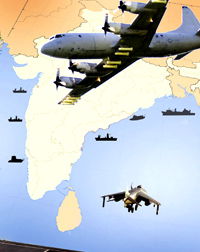INDIAN ARMED FORCES CHIEFS ON OUR RELENTLESS AND FOCUSED PUBLISHING EFFORTS

SP Guide Publications puts forth a well compiled articulation of issues, pursuits and accomplishments of the Indian Army, over the years

"Over the past 60 years, the growth of SP Guide Publications has mirrored the rising stature of Indian Navy. Its well-researched and informative magazines on Defence and Aerospace sector have served to shape an educated opinion of our military personnel, policy makers and the public alike. I wish SP's Publication team continued success, fair winds and following seas in all future endeavour!"

Since, its inception in 1964, SP Guide Publications has consistently demonstrated commitment to high-quality journalism in the aerospace and defence sectors, earning a well-deserved reputation as Asia's largest media house in this domain. I wish SP Guide Publications continued success in its pursuit of excellence.
High Tech Net to Nab Terror

NEWS
A lot is being said about the intelligence failure of central agencies and the navy that led to the attack on Mumbai but a recent review conducted by the Centre on the status of patrolling of its maritime zones across eight coastal states revealed a sordid saga of neglect and apathy. A report submitted by the Comptroller and Auditor General to the government in October pointed to the lax implementation of a central scheme to procure 26 patrol boats at a cost of Rs 25 crore for patrolling of exclusive fishing zones in the first 12 miles of the coastline of eight states. The boats were either not constructed or were lying idle and not being used for the intended purpose while authorities failed even to carry out mid-course correction, the report stated.
VIEWS
The terrorist attack of November 26 on the financial capital of the nation has driven home the reality that threat to national security from the seas is no longer hypothetical or distant. With a coastline of over 7,500 km, the issue of maritime security of India is infinitely complex and challenging. In the current scenario, ideal would be to provide the nation with a three-layered security arrangement. The agency responsible for the surveillance of the first 10 NM from the coastline is the state government- managed Marine Police (MP) or the Coastal Police. Despite substantial financial support from the Centre for the establishment of MP, majority of the coastal states have failed to take this responsibility seriously. In the recent past, lack of proper surveillance and tight control has often rendered the coastline vulnerable to intrusion by hostile elements. Even if an elaborate MP is established in the near future, the state police forces could take a protracted time to acquire the skills and orientation necessary for policing the waves.
Surveillance of the next tier, that is, between 10 and 30 NM from the coastline, is the responsibility of the Indian Coast Guard (ICG) equipped with only 75 vessels and 44 aircraft. Poorly maintained, the availability of patrol craft and aircraft is low, and consequently, the ICG can hardly measure up to the task.
The Indian Navy’s (IN) commitment to safeguarding the vital link between the well-being of the Indian economy and international commercial traffic across the oceans is incontrovertible. In the action off the Somali coast, the IN has clearly demonstrated its determination and capability to fulfill the onerous responsibility of safeguarding sea lanes. The IN is also building a credible operational capability to meet with the aspirations of an emerging regional power with strategic and national security interests extending from the Gulf of Aden to the Straits of Malacca. Preoccupied with the pursuit of lofty objectives, the IN may be less inclined to focus on coastal security.





